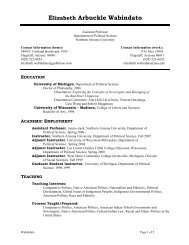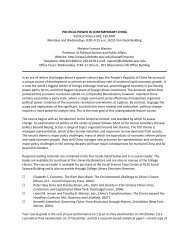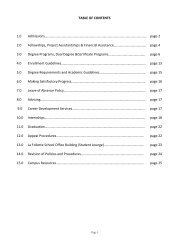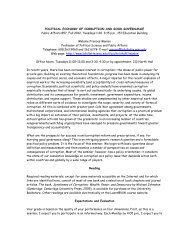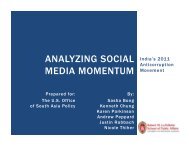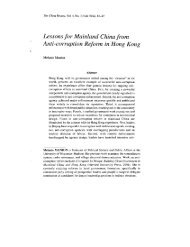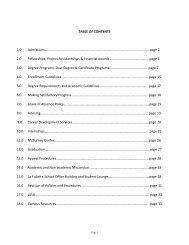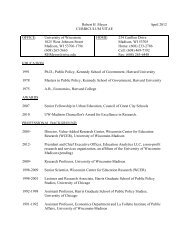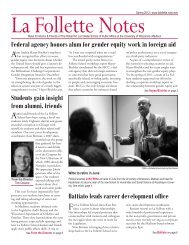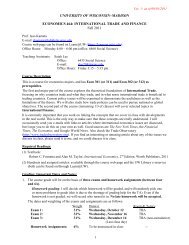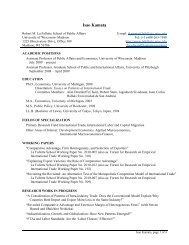SAVE Commission's findings - La Follette School of Public Affairs ...
SAVE Commission's findings - La Follette School of Public Affairs ...
SAVE Commission's findings - La Follette School of Public Affairs ...
Create successful ePaper yourself
Turn your PDF publications into a flip-book with our unique Google optimized e-Paper software.
CHAPTER<br />
FOUR<br />
GOAL #22<br />
Judicial<br />
Branch<br />
Efficient operations<br />
and effective planning<br />
Actions<br />
22.1<br />
Courts should plan for<br />
the future like other<br />
branches <strong>of</strong> government.<br />
22.2<br />
The court system<br />
should embrace<br />
technology for efficiency<br />
and service.<br />
lthough it is one <strong>of</strong> three separate but<br />
equal branches <strong>of</strong> government, the judicial<br />
branch has not had the same extent<br />
<strong>of</strong> management scrutiny as the executive<br />
and legislative branches. However, the<br />
Commission’s responsibility to look at efficiency<br />
and technology caused it to view<br />
the courts even in its limited tenure.<br />
The Commission was told the courts <strong>of</strong>fer<br />
the same opportunities for efficiency, cooperation,<br />
planning, management systems and<br />
technological improvements as other branches.<br />
State and local governments spend at least<br />
$227.8 million annually for the judicial system.<br />
Taxpayers pay again when they go to court for<br />
a legal fix that might have been avoided through<br />
mediation.<br />
SYSTEM EFFICIENCY<br />
Technology provides opportunities for<br />
greater efficiency in tracking and moving cases<br />
through the civil court system and the criminal<br />
court system (especially its overworked cases<br />
that move from police <strong>of</strong>ficer, to district attorney,<br />
to court, to corrections facility or home<br />
monitoring). It also <strong>of</strong>fers new challenges that<br />
may redefine the work <strong>of</strong> all involved.<br />
The courts should use existing technology<br />
to streamline work. Innovations such as<br />
electronic bulletin boards, satellite courthouses,<br />
E-mail and electronic record keeping, computerized<br />
scheduling, video conferencing, data<br />
searches and more, coordinated through the<br />
new <strong>Public</strong> Information Utility, can help those<br />
responsible for prosecuting and passing judgment.<br />
Video conferencing especially, already in<br />
the experimental phase, will save time and<br />
travel for all parties. <strong>La</strong>wmakers and citizens<br />
should view high-tech tools as essential courtroom<br />
investments, although that might have to<br />
be discussed in line with new revenue sources.<br />
Technology also can prevent problems.<br />
<strong>La</strong>w enforcement should be able to access digitized<br />
visual information, case law and other<br />
resources to reduce mistakes in prosecution<br />
decisions made out on the street, lake or field.<br />
This could save money by improving efficiency<br />
and reducing the state cases that get dismissed<br />
or are lost. The same data also would be available<br />
to state attorneys, making them more efficient.<br />
However, archaic laws, pr<strong>of</strong>essional attitudes<br />
and procedures may discourage efficiency.<br />
Paper, procedures and personal appearances,<br />
not electronics, drive the legal system. The legal<br />
pr<strong>of</strong>ession and the Legislature need to address<br />
these issues.<br />
Also important to savings is how the system<br />
is organized and operates. “Turf protection,”<br />
jurisdictional barriers, and lack <strong>of</strong> administrative<br />
sophistication and coordination affect some<br />
courts. Some serious problems <strong>of</strong> inefficient<br />
case management exist. The judiciary and clerks<br />
<strong>of</strong>fices should address their own inefficiencies<br />
before others step in.<br />
As recommended to the Commission, civil<br />
and criminal information should be more comprehensively<br />
systematized and available to all<br />
in the system at any time. There are successes,<br />
but the record could be better.<br />
The Commission also heard about the<br />
waste and problems in the assignment <strong>of</strong> multiple<br />
social workers to the same child or family.<br />
These frequently are working directly for, or<br />
under contract to, different agencies: corrections,<br />
schools, courts, welfare and more. The<br />
average number <strong>of</strong> social workers per child was<br />
four. The common sense approach is one per<br />
child.<br />
58 CITIZEN • COMMUNITY • GOVERNMENT — WISCONSIN: THE 21 ST CENTURY



